AMD FX-8320E CPU Review: The Other 95W Vishera
by Ian Cutress on January 13, 2015 10:00 AM ESTProfessional Performance: Windows
Agisoft Photoscan – 2D to 3D Image Manipulation: link
Agisoft Photoscan creates 3D models from 2D images, a process which is very computationally expensive. The algorithm is split into four distinct phases, and different phases of the model reconstruction require either fast memory, fast IPC, more cores, or even OpenCL compute devices to hand. Agisoft supplied us with a special version of the software to script the process, where we take 50 images of a stately home and convert it into a medium quality model. This benchmark typically takes around 15-20 minutes on a high end PC on the CPU alone, with GPUs reducing the time.
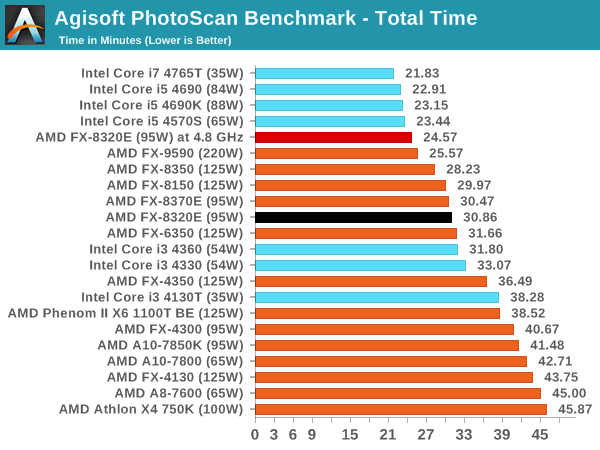
A highly parallel benchmark like Photoscan puts the FX CPUs ahead of our i3 results. When overclocked, it plays just behind the i5 results.
Cinebench R15
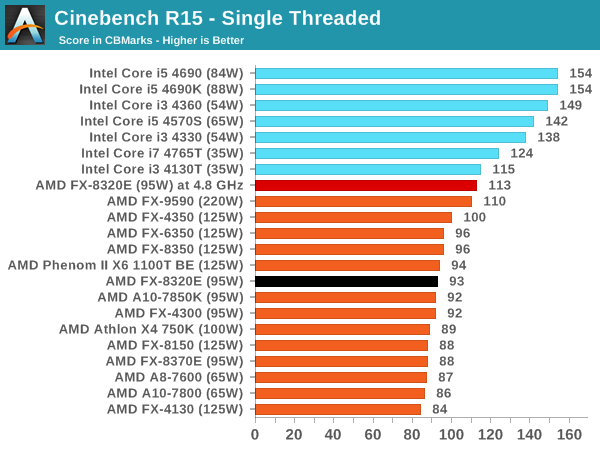
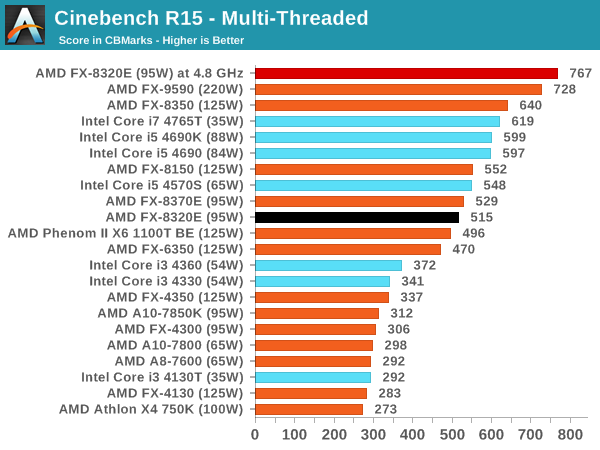
Professional Performance: Linux
Built around several freely available benchmarks for Linux, Linux-Bench is a project spearheaded by Patrick at ServeTheHome to streamline about a dozen of these tests in a single neat package run via a set of three commands using an Ubuntu 14.04 LiveCD. These tests include fluid dynamics used by NASA, ray-tracing, molecular modeling, and a scalable data structure server for web deployments. We run Linux-Bench and have chosen to report a select few of the tests that rely on CPU and DRAM speed.
C-Ray: link
C-Ray is a simple ray-tracing program that focuses almost exclusively on processor performance rather than DRAM access. The test in Linux-Bench renders a heavy complex scene offering a large scalable scenario.
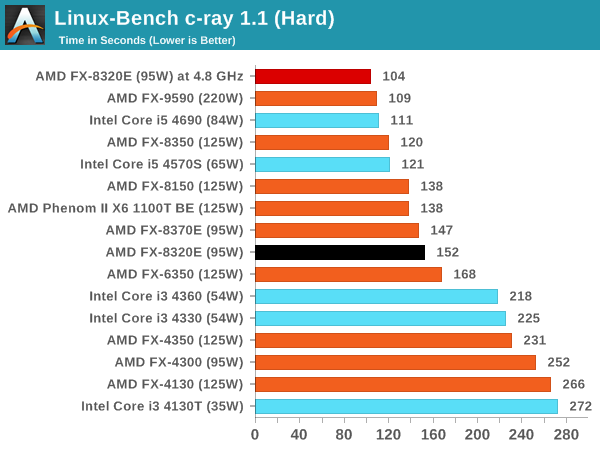
Ahead of the i3, behind the i5 until overclocked seems to be a good motto for this CPU.
NAMD, Scalable Molecular Dynamics: link
Developed by the Theoretical and Computational Biophysics Group at the University of Illinois at Urbana-Champaign, NAMD is a set of parallel molecular dynamics codes for extreme parallelization up to and beyond 200,000 cores. The reference paper detailing NAMD has over 4000 citations, and our testing runs a small simulation where the calculation steps per unit time is the output vector.
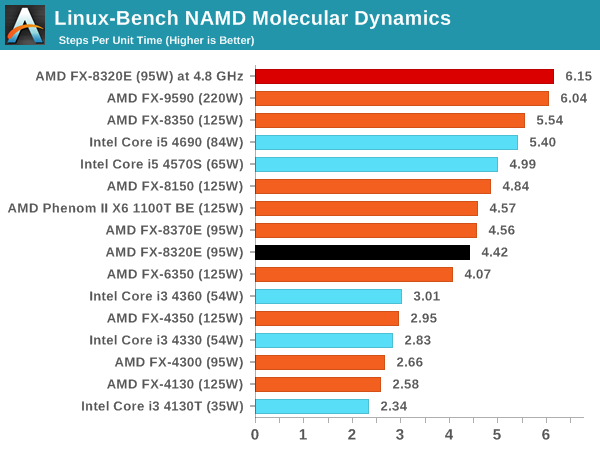
NPB, Fluid Dynamics: link
Aside from LINPACK, there are many other ways to benchmark supercomputers in terms of how effective they are for various types of mathematical processes. The NAS Parallel Benchmarks (NPB) are a set of small programs originally designed for NASA to test their supercomputers in terms of fluid dynamics simulations, useful for airflow reactions and design.
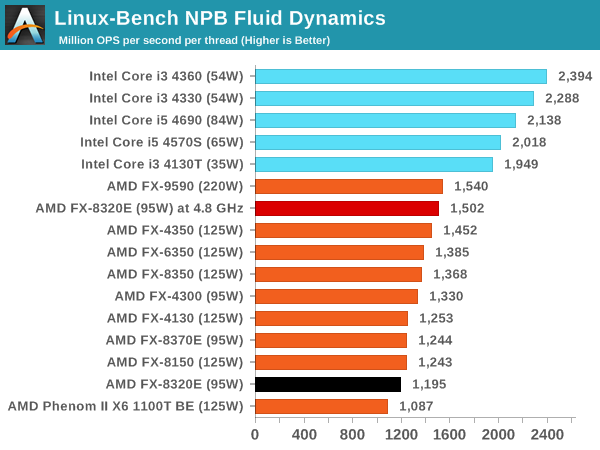
Redis: link
Many of the online applications rely on key-value caches and data structure servers to operate. Redis is an open-source, scalable web technology with a b developer base, but also relies heavily on memory bandwidth as well as CPU performance.
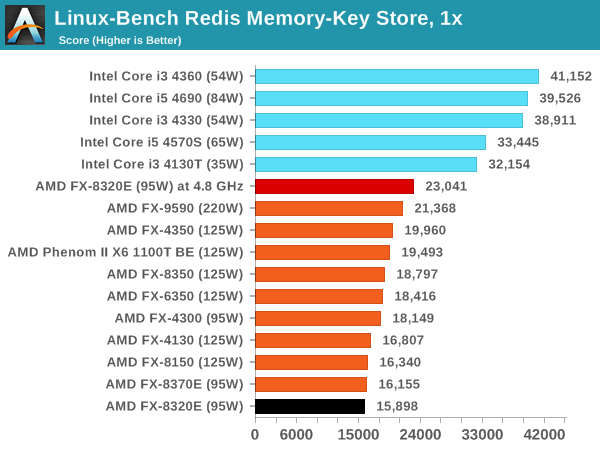
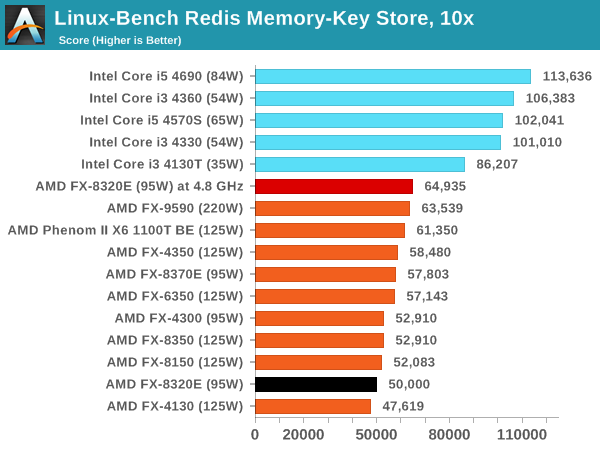
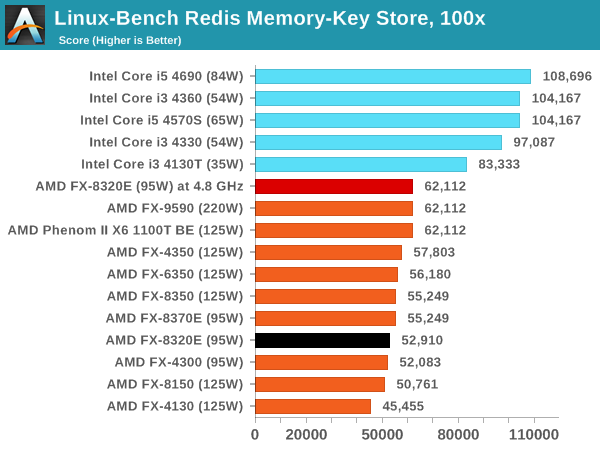
It would seem that one downside to the AMD FX line is the memory access limited scenarios, unless more cores can come into the equation. For redis, that is unfortunately not the case.










92 Comments
View All Comments
OrphanageExplosion - Wednesday, January 14, 2015 - link
I played Crysis 3 on an i3-4130 and an i5-4690K. On the jungle stages, there's a night and day difference. I suspect you would notice the same going from a 3570K down to an FX-6300. Most titles are GPU-bound, but CPU can cause frame-rate drops too.Cryio - Wednesday, January 14, 2015 - link
For Offfice an AMD APU A6 is more than enough.aphroken - Wednesday, January 14, 2015 - link
for office, a calculator and typewriter sufficesbarleyguy - Thursday, January 15, 2015 - link
Lame comment, seriously.My work laptop is a high end i7 (Dell 4800 mobile workstation), and my home office machine is an AMD FX-6300. The AMD machine feels every bit as fast.
For typical office applications, there will be no noticeable difference between an AMD and Intel CPU. The storage is generally the bottleneck, so a fast SSD is more worthwhile upgrade than a faster processor.
Even for development (which is why I have a mobile workstation), it's a barely noticeable difference. The longest part of a build is the unit tests, and they are mostly network bound.
AnandTechLies - Wednesday, January 21, 2015 - link
some guy trying to tell people to waste money on an i7. if you buy an i7 it takes up most of the money (unless you have a shit ton of money) and the rest of the Desktop Suffers and AMD processors are actually GOOD. This IMFORMATIVE website lies and has been caught faking their review benchmarks to make people buy intel over AMD, read my username and LISTEN also do not trust Tomshardware it makes up bullshit toD. Lister - Friday, January 23, 2015 - link
Do you think the regular aluminium foil is as good as a tin foil for making hats? Or can the invisible martian invaders read our thoughts through it?happycamperjack - Tuesday, January 13, 2015 - link
I agree! Complained about this before. These gaming benchmarks are some of the worst games to use for both CPU and GPU beside maybe Tomb Raider. Consumer enthusiast CPU market is pretty much dominated by gamers. If you are running irrelevant benchmarks, what's the point then?Suggestion for games to benchmarks:
Dragon Age Inquision: Incredibly well threaded and scaled. Hyperthreading actually gives a big boost in this game. A good indicator benchmark for upcoming Frostbite 3 engine games.
Crysis 3 or Ryse: Son of Rome: Very well threaded and scaled games. Good benchmarks for upcoming crytek games.
Maybes:
Far Cry 3: I'd suggest Far Cry 4 when it's fixed. Another very well threaded game that's a well representation of open world game.
Metal Gear Ground Zeroes: Good benchmark for upcoming FOX engine games such as the popular Pro Evolution series.
I would also suggest AC Unity if it's not so broken for multi GPUs. Yea SLI and Crossfire is still broken this moment.
MapRef41N93W - Wednesday, January 14, 2015 - link
Tomb Raider is horrible for CPU comparisons. One of the absolute worse GPU intensive games for testing CPU on the market. A Pentium G3258 can almost match a 4770k in that game.OrphanageExplosion - Wednesday, January 14, 2015 - link
Tomb Raider is useful for GPU testing as it's very heavy on GPU ramped up to the max but you're right in that its CPU usage is minimal.OrphanageExplosion - Wednesday, January 14, 2015 - link
I actually played Tomb Raider on a G3258 and a 4790K. With a 4.5GHz OC in place (and v-sync active), the Pentium was a total match for the i7. However, at stock speeds, the Pentium saw clear lag in CPU-heavy area - physics etc.However, the benchmarking sequence doesn't have any physics-heavy elements.
Reviewers need to start actually playing games and finding the bottleneck areas rather than just running canned benchmarks that prove very little. If that means fewer datapoints so be it. I'd rather have a smaller amount of useful data rather than a larger amount of meaningless data.